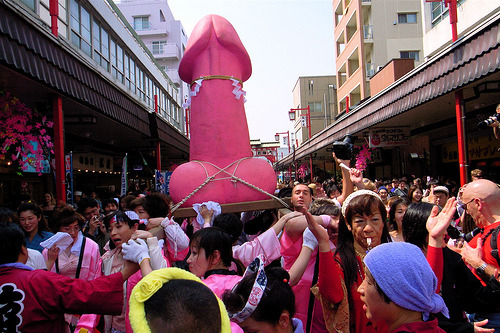Throughout History - A society’s attitude toward public nudity can reveal a great deal about its culture, attitudes and sometimes its religious beliefs. Nudity is sometimes extended to all areas of life, while in other contexts it is confined to certain settings or activities. For instance, some societies condone nudity during athletic activities, while encouraging the wearing of clothing at other times. Standards vary widely from one culture to another.
The practice of habitually wearing clothes is a fairly recent invention in human history. In primeval times our distant ancestors, evolving in Africa and migrating into a world of tropical and temperate climates, were certainly naked most or all of the time. However, as humans expanded into colder areas, they quickly had to adapt artificial covering, and as soon as they did that, they also started adopting customs to govern what clothing should be worn, and when it should be worn. In different societies clothing or the lack of it has been seen as being sexual in nature, as connoting social status or the lack of it, as indicating a certain religious or philosophical affiliation, or as indicating a certain economic station. Ancient texts from many cultures refer to the poor and downtrodden as naked, and in a society with that attitude, a person who could afford clothes would certainly wear them to show that they were not poor and downtrodden. It is easy to see how clothing quickly became more than a utilitarian body covering, and began to assume other social meanings.

In some ancient societies, the display of the body was linked to a certain religious philosophy. For instance, the Egyptian Pharaoh Akhenaten, who ruled from about 1353 to 1336 B.C., worshiped the sun disc and believed that the body should be proudly displayed in its light. Depictions of Akehnaten and his queen, Nefertiti, show them wearing very little clothing at all, basking in the holy light of the sun.

While Akhenaten may have been the first of the pharaohs to attach a religious connotation to the practice of public nudity, he certainly did not invent the concept in Egyptian culture. Egyptian depictions from much earlier periods also show people wearing no clothes, or clothing that was form-fitting and even transparent. The ancient Egyptians were quite open about sexuality, and attached a strong erotic connotation to their near-nakedness. Artwork from ancient Egypt sometimes depicts sexual acts in very explicit and even comical ways.



Some other ancient groups attached less of an erotic meaning to nakedness. In India, for instance, certain religious sects required nudity as a sign of the renunciation of worldly possessions. Our knowledge of this comes from Greek historians of the time of Alexander the Great, who reported that there were several of these sects, the largest of which was called the Ajivikas.
The Greeks called these groups gymnosophists, from their word gymnos, meaning naked. The point to be stressed here is that this was a completely different meaning for nudity than in the Egyptian culture. While the Egyptians were openly erotic and obviously took great pleasure in displaying their bodies, the Indian ascetics used nudity as a sign of giving up worldly pleasure and adopting a pure and holy attitude.
However, nudity in ancient India was not strictly an ascetic thing, for the Hindu religion also recognized the holiness of sexuality. A Hindu sect called the Sakas, who were flourishing about a thousand years ago, decorated their temples with explicitly erotic artwork. Sexuality was seen as a holy thing, the procreative force of the divine. Such erotic sculpture can still be seen today at Indian sites such as Khajurako, Konarak and Ellora.

The Greeks had a tradition of nudity that involved both a frank admiration for the beauty of the human body and a deep-seated religious philosophy. The Greeks believed that their gods had created humans to look like themselves, so there was no shame in displaying our own godlike forms. Greek deities are generally depicted as perfect physical specimens wearing few if any clothes, and their mortal worshipers adopted a similar style. Greek garments were simple pieces of cloth draped or wrapped around the body, quickly removed at a moment’s notice.
If a person in ancient Greece were working or playing hard, they would think nothing of removing the garment. The Greeks were saying, “Our gods are beautiful, and since we look like the gods, we are beautiful, too.” In particular, it was expected that athletes would be nude when they engaged in sports. Our word gymnasium comes from the Greek gymnos meaning naked, since the people who exercised there always were.

The Romans adopted much of the culture of their Greek predecessors, but in Roman society nudity was strictly confined to certain settings and activities. Romans were expected to wear clothes in most public places, but nudity was condoned and even expected in athletic activities, in the public baths and at public latrines. The acceptance of nudity in athletics, and particularly in gladiatorial competitions, was probably a practice inherited from the Etruscans, another cultural predecessor of the Romans. Etruscan sculpture even depicts gladiators fighting completely naked.
The Greeks had a tradition of nudity that involved both a frank admiration for the beauty of the human body and a deep-seated religious philosophy. The Greeks believed that their gods had created humans to look like themselves, so there was no shame in displaying our own godlike forms. Greek deities are generally depicted as perfect physical specimens wearing few if any clothes, and their mortal worshipers adopted a similar style. Greek garments were simple pieces of cloth draped or wrapped around the body, quickly removed at a moment’s notice. If a person in ancient Greece were working or playing hard, they would think nothing of removing the garment. The Greeks were saying, “Our gods are beautiful, and since we look like the gods, we are beautiful, too.” In particular, it was expected that athletes would be nude when they engaged in sports. Our word gymnasium comes from the Greek gymnos meaning naked, since the people who exercised there always were.
The Romans adopted much of the culture of their Greek predecessors, but in Roman society nudity was strictly confined to certain settings and activities. Romans were expected to wear clothes in most public places, but nudity was condoned and even expected in athletic activities, in the public baths and at public latrines. The acceptance of nudity in athletics, and particularly in gladiatorial competitions, was probably a practice inherited from the Etruscans, another cultural predecessor of the Romans. Etruscan sculpture even depicts gladiators fighting completely naked.

Another ancient society that relegates nudity to certain places and times is that of Japan. While Japanese culture allows the frank discussion of erotic subjects, and even the teaching of sexual techniques to prospective newlyweds, nakedness is generally frowned upon. The nude human body is not considered a fitting subject for art, and even paintings of lovers in bed show them fully clothed. However, Japanese culture also makes allowance for group bathing, often by large family groups. Until the 20th century, such communal bathing was a regular part of daily life for many Japanese, and even today it is still practiced in some out-of-the-way places.

Similar group bathing practices can be found in the cultures of ancient Turkey and some northern European cultures such as those of Scandinavia. All of these cultures strongly discouraged nudity in other public settings.
Certainly one of the most repressive cultures regarding the public display of the human body was that of ancient China. Here the covering of the body was considered a prerequisite of humanity. Other ethnic groups who did not cover their bodies were considered subhuman, and a strong sense of physical modesty was taken as evidence of the superiority of Chinese culture. Women were not even allowed to uncover their bodies for their doctors, and had to point out their aches and pains on dolls specially made for the purpose.
Paganism, both in its ancient and modern forms, makes use of ritual nakedness which is usually confined to certain places and occasions. Those who adhered to Wicca or some other ancient religions would sometimes dance naked, or “sky-clad” during seasonal rituals. Among those who hold such beliefs today, the practice is sometimes still carried on. In these contexts, nakedness is seen as a state of naturalness which makes the worshiper more receptive to divine power. As in other societies, nudity is closely linked to both religious belief and sexual abandon, which are not seen as being opposed to each other.

From:
http://youngnaturistsamerica.com/naturism-nudism-throughout-history/